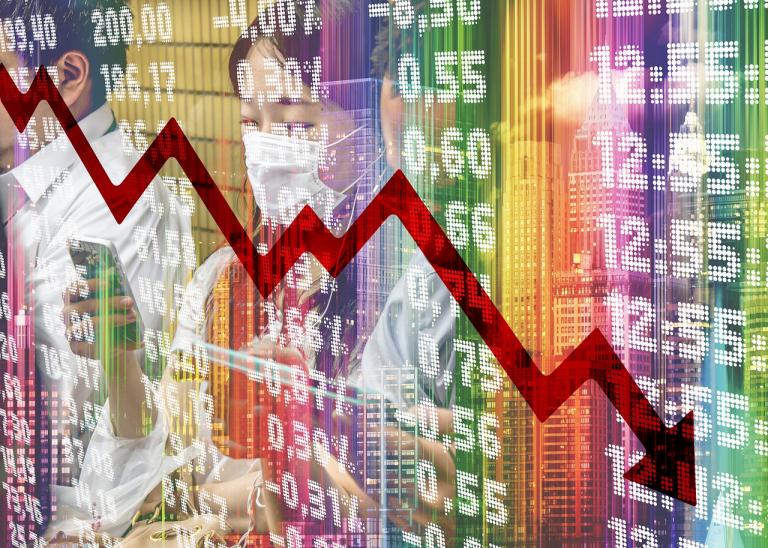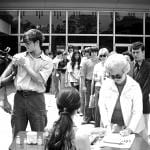The coronavirus infects and threatens the lives of individuals. It has also infected and threatens the life of our economy. The symptoms of the economic infection include not only massive unemployment and the shutdown of entire industries, but also bizarre economic distortions.
The biggest impact, of course, is unemployment. One out of six Americans is now out of work, the highest level since the Depression. This is due to the government-mandated shutdown of much of the nation’s businesses. This has been described, to continue the medical metaphor, as putting the entire economy into an induced coma, in hopes that it will recover when we can cure the epidemic. But entire sectors of the economy–restaurants, hotels, airlines, travel, retail–are in critical condition and many businesses are dead or dying.
I would like to focus here, though, on the strange symptoms of our virus-infected economy.
Both Oversupply and Shortages
Supermarkets are doing well, but shoppers are finding empty shelves or “one-to-a-customer” limits on perishable staples such as milk, eggs, and meat. At the same time, farmers are pouring milk onto the ground, breaking their eggs, and euthanizing livestock.
How can we have both too much supply, to the point that farmers cannot sell what they produce, AND shortages in the face of growing consumer demand?
Well, to show just how prosperous we had been just a few weeks ago, 54.4% of what Americans spent for food has been for eating out. On average, Americans have been eating out 4.2 times a week, or 18.2 times per month. Some affluent people eat virtually all of their meals at restaurants, just as some low income folks eat virtually all of their meals at fast food joints.
All of a sudden, thanks to the coronavirus measures, restaurants have shut their doors. Now everyone who has been eating at restaurants must shift to eating at home. This means not only learning to cook in some cases but buying their food from grocery stores.
Grocery stores thus have more customers buying more food, a sharp increase in demand. Regular customers too are buying more, not simply to hoard, though there is some of that, but because stay-at-home requirements mean going shopping less frequently–according to some guidelines just once every two weeks–so that when customers do venture out in their masks and social distancing, they buy more per trip. So food keeps flying off the shelves.
As this is happening on the demand side, from the supply side, there is another disruption. The food industry is divided into suppliers of the retail market and suppliers of the restaurant market. So much of America’s food production is geared to restaurants and other large-scale buyers, such as schools and other institutions.
Thanks to the coronavirus measures, those larger-scale buyers are mostly closed. That means that their food-service suppliers have products that no one is buying.
Those suppliers could transition into the retail market, and some are, to the extent they can, but that is not easy. Companies used to selling flour in 50 pound bags or milk in individual serving for school lunches must change their packaging to sell in supermarkets. The processing, warehousing, and delivery systems must all be changed. And companies are reluctant to go through all of this, not knowing how long the restrictions will last. It would not be feasible to make all of the necessary changes if, in a couple of months, they would have to change them all back again.
Further complicating matters is that many food processing factories–particularly, meat-packing operations–are being shut down because their workers, who must labor in close proximity to each other, are either getting the coronavirus or are afraid of getting it or can’t come to work because they have to stay home with their kids because the schools are closed. Or in many cases preferring to file for unemployment so they can make more money than they would by working (see below).
And, as usual, the farmer who produces our food supply is especially hurt. When meat processing plants shut down, there is no one to buy farmers’ hogs and cattle. When milk companies no longer have the school lunch market, dairy farmers cannot sell all of their milk. When there are no more restaurants serving breakfast, the market for eggs, 30% of which are sold in bulk to restaurants, dries up. And since milk and eggs are highly perishable and since livestock that can’t be sold have to be fed and feed is expensive, farmers have no choice but to destroy what they produce.
A Labor Shortage at the Same Time as Soaring Unemployment
The CARES act designed to keep the economy on life support tacks on $600 per week to unemployment benefits. Say a factory worker gets a fairly decent wage at $20 per hour. That would come to $800 per week. In most states, the unemployment benefit comes to about half a worker’s weekly wage. That would be in this case $400 per week. But with the $600 per week supplement from the federal government, that would come to $1000 per week. Which is more than what the individual would get working!
The effect is even greater in other jobs that pay an hourly wage, most of which pay far less than $20 per hour. This has become a huge problem for the food industry, in addition to the ones we just discussed. This will be another hurdle for restaurants and small businesses in general once they can re-open. Typically, unemployment benefits last for six months.
The disincentive to work is very large. According to this article on restaurants, some laid off employees are doubling income by not working. In accord with the rational self-interest that is supposed to govern economic behavior, why would they go back to work until after their unemployment benefits are exhausted?
This is also impacting other “essential” businesses, such as retailers like WalMart, manufacturers of masks and other medical equipment, nursing home employees, etc., etc. All of these industries are hiring. But they are having trouble re-hiring workers they had to lay off earlier and hiring new workers to meet the soaring demand.
So at a time when six out of ten Americans are unemployed, the companies that are hiring are trying to deal with a labor shortage!
Paying Customers to Take What You Are Selling
Last week, oil sold for a minus $40 per barrel. That is, sellers were paying buyers $40 a barrel to take the oil off their hands.
Already there was a glut of oil on the world market. Saudi Arabia and Russia had been feuding with each other, with the Saudis increasing production to hurt the price that the Russians could get. And both of them wanted to hurt the United States, where fracking and other technological innovations have resulted in vastly increased oil production, making the U.S. a net exporter of oil.
That was the supply side. On the demand side, the coronavirus shutdown hit. Travel came to a halt. Airlines no longer needed to buy fuel. Workers from home no longer needed to commute. Meetings and vacations were cancelled. States imposed travel restrictions. Factories and other businesses that used petroleum as a fuel or raw material closed. So the demand for oil plummeted.
That the price of oil went negative was largely a quirk of the futures market, in which dealers try to lock in prices with contracts to buy and deliver months in advance. Commitments to deliver in May came due, but because of the glut from both the supply and the demand side, which no one predicted, vast amounts of oil came on the market. And there was no place to put it.
All of a sudden, the oil world’s attention was fixated on Cushing, Oklahoma–population 7,800–where the oil pipelines meet and where much of the nation’s oil storage facilities are located. Cushing is just an hour and a half or so from where we live! But now Cushing was full!
So the desperate traders had to give their oil away. When that didn’t work, they had to pay people to take it. And since there were few takers, they had to pay more and more.
The actual price of oil is $17.18, which is low enough. Not that long ago it was $88.
Gasoline is selling for $1.35 per gallon or less, but since driving has dropped off so much, consumers can’t take full advantage of that price, the lowest in decades. Meanwhile, states like Oklahoma, which depend on tax revenue from the oil fields and as thousands of jobs that have now evaporated, are in further trouble.
Europe has seen similar negative pricing for electricity and–with negative interest rates–for money in savings accounts and other investments.
Medical Layoffs in Time of Medical Need
In this time of pandemic, medical professionals–physicians, nurses, researchers, hospital workers–are the heroes, bravely risking and sometimes giving their lives to care for coronavirus victims.
And yet, medical workers are getting laid off, hospitals are going broke, and doctors’ practices are in jeopardy.
This is because the coronavirus measures have practically shut down the health care industry except for the coronavirus.
Hospitals and surgeons are not allowed to perform “non-essential surgery,” which includes hip-replacements, cataract removals, and other procedures that, while they do not have to be performed immediately, are still important to patients. And such operations are the major revenue-producers for the health-care industry.
Also, hospitals have had to reserve their intensive care units and bed space for COVID-19 patients. But, except for a few places, these are not being used! The hospital rooms are empty, as infections fall short of the models’ projections, which means expense without revenue and the necessity to lay off staff.
Thus, hospitals in rural and small towns are going bankrupt and closing permanently. They aren’t allowed to perform elective and non-emergency surgeries or other treatments in order to keep facilities open for COVID-19 patients. But in many of these cases, there are no COVID-19 patients.
Our economy is not just experiencing a downturn, as regularly happens in economic cycles. Because of this virus and our nation’s reaction to it, our economy, like a coronavirus patient, is sick.
Image by Gerd Altmann from Pixabay












